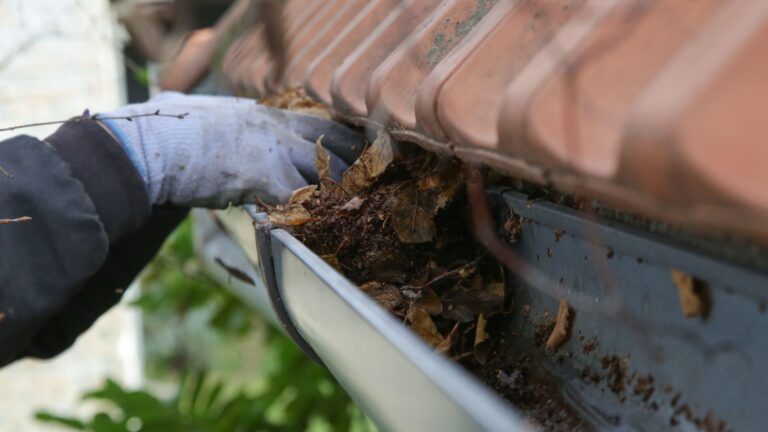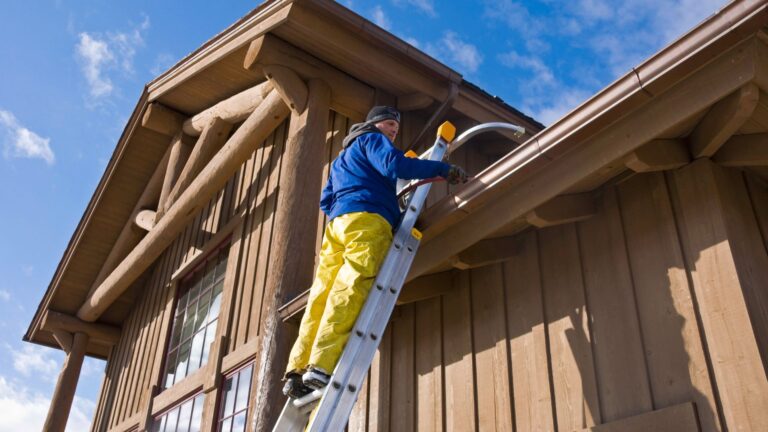Gutters may seem like a minor component of your home, but their role is far more important than many homeowners realize. Designed to direct rainwater away from your roof, walls, foundation, and landscaping. Gutters help prevent a wide range of costly and damaging issues. However, when they become clogged or broken, they can lead to water infiltration, structural deterioration, and even indoor air quality problems. Unfortunately, many homeowners overlook gutter maintenance until visible signs of damage appear. By then, the repairs can be extensive and expensive.
Neglecting your gutters doesn’t just put the exterior of your home at risk—it can also affect your interior, your health, and your property’s overall value. From foundation cracks and basement flooding to mold growth and pest infestations. The consequences of ignoring gutter care can escalate quickly. What begins as a simple maintenance task can turn into thousands of dollars in repairs if left unattended.
This article explores the often-overlooked dangers and hidden costs of gutter neglect. Explains why proactive maintenance is one of the smartest and most cost-effective investments a homeowner can make.
Table of Contents
Why Gutter Maintenance Is Essential for Home Protection
Gutters play a vital role in protecting your home by efficiently directing rainwater away from the roof, foundation, and surrounding landscape. When working properly, they help prevent water from pooling around your property—a common cause of soil erosion, basement leaks, and foundation damage. Without a dependable gutter system, rainwater can seep into unwanted areas, leading to rot, mold growth, and long-term structural issues. In addition, gutters safeguard your siding, windows, doors, and even your driveway from moisture-related damage and deterioration.
Keeping gutters clean and free of debris is essential to ensure they perform their job. Leaves, twigs, and dirt can quickly clog the system, causing water to back up and overflow. As a result, this overflow can damage fascia boards, stain exterior walls, and even leak into your attic or ceiling. Routine gutter cleaning—especially during the fall and spring—helps prevent these issues before they start. Furthermore, regular inspections and timely maintenance not only extend the life of your gutter system but also help you avoid costly home repairs in the future.
Clogged Gutters and Foundation Damage: A Costly Connection
Clogged gutters may seem like a small inconvenience, but over time, they can lead to serious and costly foundation problems. When gutters become blocked, water overflows and pools near your home’s base instead of being safely diverted away. As a result, this constant water exposure saturates the soil around the foundation, increasing hydrostatic pressure and weakening the structural support. Eventually, as the pressure builds, cracks may begin to form in the foundation walls. Leading to long-term damage that can compromise the stability of your entire home. In extreme cases, foundation settling or shifting may occur, making repairs both complex and expensive.
Here’s how clogged gutters contribute to foundation damage:
Water overflow saturates the soil surrounding your foundation. Which expands and contracts with changing moisture levels ultimately causing stress and cracks in the foundation walls.
Basement flooding becomes more likely when excess rainwater seeps through cracks and poorly sealed joints. Resulting in mold growth, ruined finishes, and damaged flooring.
Erosion around the base of the home removes critical soil support. Which can allow the foundation to sink or become uneven over time.
Increased hydrostatic pressure from standing water can cause basement walls to bow inward or crack. Threatening the structural integrity of your property.
Repair costs can vary widely depending on severity, but homeowners can expect to spend anywhere from $4,000 to over $15,000 on foundation repairs. Especially if major stabilization work or drainage correction is needed.
Therefore, proactive gutter maintenance—such as seasonal cleaning. Checking downspout extensions, and installing gutter guards—can significantly reduce the risk of water-related foundation issues and protect your home’s long-term value.
Roof Damage from Blocked Gutters: What You’re Risking
Blocked gutters may seem like a minor inconvenience, but they can cause significant and costly damage to your roof over time. When rainwater or melting snow cannot flow properly through the gutter system, it begins to pool, overflow, and back onto your roof—leading to a series of problems that compromise both the structural integrity and lifespan of your roofing materials. The longer the issue goes unchecked, the more likely your roof will suffer water intrusion, wood rot, and expensive damage that could have easily been prevented.
Ice Dams and Water Backup in Cold Weather
In colder climates, one of the most serious consequences of blocked gutters is the formation of ice dams. When snow on the roof melts and cannot drain through clogged gutters, the water refreezes at the edge of the roof, creating a dam. This ice barrier traps additional melting snow behind it, forcing water under the shingles and into the roof deck. This can lead to leaks, water-stained ceilings, and even mold growth inside your home. Ice dams also add weight to the gutters themselves, increasing the risk of detachment or collapse.
Shingle Deterioration from Standing Water
When gutters overflow during heavy rain, water can collect along the edge of the roof and seep beneath the shingles. Over time, this constant exposure to moisture causes the shingles to deteriorate—they may warp, crack, or curl, leaving the underlying structure vulnerable. Damaged shingles lose their effectiveness in protecting your roof from the elements, increasing the risk of leaks and shortening the life expectancy of your roofing system.
Rotted Fascia Boards and Roof Decking
Another hidden danger of blocked gutters is the damage caused to fascia boards and roof decking. When water spills over clogged gutters, it often flows behind them and soaks into the fascia—the wooden boards that support the gutter system. Persistent exposure leads to wood rot, mold, and decay, weakening the structural support. In more advanced cases, water can penetrate the roof deck beneath the shingles, causing sagging, soft spots, and further rot that may require extensive repairs or even partial roof replacement.
Why Gutters Are Crucial to Your Roof’s Lifespan
Your gutter system plays a vital role in preserving the integrity and longevity of your roof. By directing rainwater away from the roof edge, gutters prevent standing water, shingle damage, and wood rot. A clean, functional gutter system helps extend the life of your roof by reducing moisture exposure and protecting structural components from deterioration. Investing in routine gutter maintenance is not just about keeping them clear—it’s about protecting one of the most valuable parts of your home from avoidable, costly damage.
Gutter Neglect and Interior Water Damage
When gutters are clogged or poorly maintained, the overflowing water doesn’t just damage the exterior of your home—it can find its way inside. As rainwater backs up and spills over the sides, it often runs down exterior walls and seeps into cracks, windows, and roofing edges. Over time, this can lead to leaks inside your home, showing up as water stains on ceilings, bubbling paint, or peeling wallpaper. Left unaddressed, the water intrusion can penetrate deeper into the walls and ceilings, causing structural damage that’s both costly and inconvenient to repair.
One of the most common consequences of interior water damage from neglected gutters is compromised drywall and insulation. Saturated drywall becomes soft, stained, and may even collapse in severe cases. Moisture also creates the perfect breeding ground for mold and mildew, which damages materials, but also poses serious health risks. Insulation, once wet, loses its effectiveness, increasing energy bills and reducing indoor comfort. Repair costs can quickly escalate—ranging from hundreds for cosmetic fixes to thousands for mold remediation and structural repairs. Taking simple steps to maintain your gutter system can prevent these long-term headaches and protect both your home’s interior and your peace of mind.
Mold and Mildew: The Hidden Health Hazard of Poor Gutter Maintenance
Neglecting gutter maintenance doesn’t just impact your home’s structure—it can also affect your family’s health in serious ways. When gutters become clogged and overflow, excess water can seep into walls, ceilings, and basements. This trapped moisture creates a perfect environment for mold and mildew to grow, especially in areas with limited ventilation or high humidity. What may start as a small moisture problem can quickly evolve into widespread mold contamination if not addressed promptly.
Many homeowners don’t associate gutter maintenance with indoor health risks, but the connection is stronger than it appears. Water from overflowing gutters often seeps into hidden areas—behind walls, under floors, and into attics—where mold can flourish unnoticed for months. By the time visible signs appear, such as musty odors or black spots on walls, the damage is often extensive. Preventative gutter care is not just a home maintenance task—it’s a frontline defense against health hazards that can silently spread through your living space.
Health Effects: Allergies, Asthma, and Respiratory Problems
- Mold spores released into the air can trigger allergic reactions, such as sneezing, skin irritation, and watery eyes.
- Individuals with asthma may experience increased attacks and difficulty breathing when exposed to mold.
- Long-term exposure to mold can lead to chronic sinus infections and persistent coughing.
- Young children, the elderly, and those with weakened immune systems are especially vulnerable.
- Toxic mold species, like black mold, can produce mycotoxins that may cause more severe neurological or respiratory issues.
Indoor Air Quality Impact from Neglected Gutters
When mold grows unchecked due to water intrusion from clogged gutters, it can significantly impact the air quality inside your home. Mold spores often circulate through your HVAC system, spreading to different rooms and becoming part of the indoor environment. This leads to poor air quality, which not only affects comfort but also poses serious health risks and leads to costly remediation. By keeping your gutters clean and functional, you help prevent water intrusion and protect the health of everyone living in your home.
Maintaining good indoor air quality is essential for a healthy living space, and mold caused by poor gutter drainage can be a hidden danger. As spores become airborne, they compromise the purity of the air—posing a particular risk to individuals with respiratory conditions, allergies, or sensitivities. Over time, consistent exposure can result in chronic health issues and frequent illness. That’s why investing in regular gutter inspections and cleaning is one of the simplest and most effective ways to ensure your indoor environment remains safe, breathable, and free from invisible contaminants.
Pest Infestations Caused by Standing Water in Gutters
Clogged gutters filled with stagnant water and organic debris create the perfect habitat for unwanted pests. From disease-carrying mosquitoes to wood-destroying termites and curious rodents, a neglected gutter system can invite a variety of infestations that not only threaten your comfort but also your home’s structural safety. Once pests settle in, they can quickly multiply, cause damage, and even find their way indoors. What may seem like a simple maintenance task can quickly turn into a pest control emergency if ignored.
- Standing water in gutters serves as a breeding ground for mosquitoes, increasing the risk of West Nile virus, Zika, and other mosquito-borne diseases.
- Termites and carpenter ants are attracted to damp, decaying wood, often found in fascia and soffit boards soaked by overflowing gutters.
- Rats and mice use gutter debris to nest, and clogged downspouts can give them access to your attic or walls.
- Birds and squirrels often make nests in clogged gutters, causing further blockages and noise, and damaging nearby roofing materials.
- Wasps and bees may build hives near standing water or in gutter troughs, creating a dangerous environment around your home.
- Clogged gutters can lead to hidden entry points, as pests chew through weakened or rotting areas to get indoors.
- Regular gutter cleaning disrupts pest habitats, reduces nesting materials, and eliminates stagnant water sources.
- Installing gutter guards and proper drainage systems can further deter pest activity and reduce long-term risks.
- Gutter maintenance paired with seasonal pest inspections offers a comprehensive approach to keeping your home pest-free year-round.
Landscape and Curb Appeal Damage from Overflowing Gutters
Overflowing gutters don’t just affect your roof and foundation—they can also cause significant damage to your landscaping. When this happens, water spills over clogged gutters and pours directly onto the ground with force. As a result, it erodes soil and washes away mulch or topsoil. This runoff, in turn, disrupts the balance of your yard, damages flower beds, and even exposes plant roots. Consequently, it becomes harder for your garden to thrive. Over time, the constant water flow can leave unsightly ruts or channels in your lawn. Eventually, this gives your property a worn and neglected appearance.
In addition to that, clogged gutters can also damage hardscaping features. Paved walkways, patios, and driveways are vulnerable to pooling water. When water seeps into cracks, it weakens the surface. As a result, this can lead to premature cracking, staining, or shifting of pavers and stones. If you’ve invested in professional landscaping or exterior upgrades, overflowing gutters can undo that effort and expense—often before you’re even aware of it.
Furthermore, beyond physical damage, clogged gutters can affect your home’s curb appeal. Water stains on siding, algae growth near the base, and worn landscaping all signal neglect. For homeowners looking to sell, this can hurt both the marketability and perceived value of the home. Therefore, regular gutter maintenance is key to keeping your outdoor spaces beautiful, functional, and an asset to your property’s overall presentation.
Gutter Repairs vs. Replacement: What Ignoring Issues Can Lead To
Neglecting minor gutter issues may seem harmless at first, but small problems can quickly escalate into costly damage that requires full system replacement. Leaks, sagging, or rusted sections are often signs that your gutters need attention. When left unaddressed, these seemingly minor issues can allow water to overflow, damaging fascia boards, siding, and even your home’s foundation. What could have been resolved with a simple repair or cleaning, if addressed early, can snowball into thousands of dollars in property damage and a full gutter replacement.
It is important to understand when to repair versus when to replace your gutters. While repairs are typically more affordable and suitable for newer gutters with isolated damage, older systems that frequently clog or show widespread wear may no longer be worth salvaging. In such cases, replacement might carry a higher upfront cost, but it is often a smarter long-term investment. This is especially true when paired with low-maintenance solutions like gutter guards. Ultimately, proactive maintenance not only saves you money, but also preserves your home’s structural integrity.
Aspect | Gutter Repairs | Gutter Replacement |
Scope of Work | Fixing minor leaks, resealing joints, reattaching loose sections | Removing old system entirely and installing a new one |
Typical Causes | Small cracks, clogs, sagging from minor wear and tear | Extensive rust, major sagging, frequent leaks, or aged materials |
Average Cost (USA) | $150 – $400 depending on damage and home size | $1,000 – $2,500+ depending on material (aluminum, copper, etc.) and home size |
Frequency | Can be done as needed with seasonal maintenance | Usually needed every 20–30 years or after severe storm/foundation damage |
Warning Signs | Dripping from seams, minor overflow, rust spots | Pulling away from roofline, severe sagging, rotted fascia behind gutters |
Consequence of Delaying | Small issues worsen, leading to widespread system failure | Higher risk of foundation, roof, and landscape damage due to total system failure |
When It’s Better to Repair | Gutters are relatively new, damage is limited and localized | Repairs are significantly cheaper and effective in the short term |
When It’s Better to Replace | Gutters are aging, repeatedly clogging, or showing multiple points of failure | Replacement is more cost-effective long-term and improves home protection |
Maintenance Cost Comparison | Routine cleaning: $100–$300 twice a year | Delayed replacement cost: $2,000+ plus potential home repair costs |
Pro Tip | Address small problems early to avoid bigger bills | Consider gutter guards to extend the life of a new system and reduce maintenance |
How to Know Your Gutters Are Failing: Key Warning Signs
Overflowing During Rainstorms
If water spills over the sides of your gutters during rain, it’s a strong indication of blockages or an improper slope. This type of overflow can lead to foundation damage, landscaping erosion, and even basement leaks.Sagging or Pulling Away from the House
Gutters that droop or begin to detach from the fascia board are often weighed down by debris or standing water. This not only disrupts proper water flow but can also damage your roofline and exterior trim.Rust, Cracks, or Visible Plant Growth
Any signs of rust, cracking, or plants growing out of your gutters suggest prolonged neglect. These issues typically point to moisture retention, poor drainage, and an increased risk of structural failure.Peeling Paint or Water Stains on Siding
Water escaping from clogged or damaged gutters can run down the exterior walls of your home. This often results in peeling paint and visible water stains—especially just below the gutter lines.Pooling Water Around the Foundation
If you notice standing water near your home’s base after rainfall, failing gutters may be to blame. Left unaddressed, this can lead to serious and costly foundation problems.Mold or Mildew Around Eaves and Fascia
Constant moisture from leaking or overflowing gutters creates an ideal environment for mold and mildew growth. This can compromise your home’s building materials and negatively impact indoor air quality.
Preventative Gutter Maintenance: Save Money and Protect Your Home
Preventative gutter maintenance is a smart and cost-effective way to safeguard your home from long-term damage. To begin with, establishing a consistent seasonal cleaning schedule—ideally in the spring and fall—helps keep your gutters free of leaves, twigs, and debris that cause clogs and overflows. In particular, homes surrounded by trees or exposed to frequent storms may require additional cleanings throughout the year. Additionally, regular inspections allow homeowners to catch early warning signs like small leaks, loose brackets, or sagging sections before they escalate into serious structural issues.
Moreover, investing in gutter guards and professional cleaning services can further enhance your gutter system’s performance and longevity. Gutter guards significantly reduce debris buildup, thereby minimizing frequent maintenance and helping prevent clogs altogether. At the same time, hiring professionals ensures thorough cleanings and expert eyes on potential problem areas that often go unnoticed. Although these services involve upfront costs, in the long run, they help prevent thousands of dollars in future expenses related to roof repairs, water damage, mold remediation, and foundation issues—ultimately making preventative gutter care a wise investment for every homeowner.






